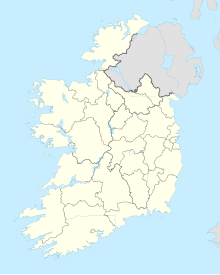Craggaunowen
Creagán Eoghain | |
 Conical hut on the reconstructed crannóg | |
 Location within Ireland | |
| Established | 1965 |
|---|---|
| Location | Craggaunowen, Kilmurry, County Clare, Ireland |
| Coordinates | 52°48′40″N 8°47′37″W / 52.811077°N 8.793654°WCoordinates: 52°48′40″N 8°47′37″W / 52.811077°N 8.793654°W |
| Type | open-air museum |
| Founder | John Hunt |
| Public transit access | none |
| Nearest car park | On-site |
| Website | www |
Craggaunowen is a 16th-century castle and an archaeological open-air museum in County Clare, Ireland.
Craggaunowen is located 10 km east of Quin, County Clare. The name Craggaunowen derives from its Irish name Creagán Eoghain (Owen's little rocky hill).[1] The site is operated by Shannon Heritage.[2]
Castle[]
Craggaunowen Castle was built around 1550 by John MacSioda MacNamara, a descendant of Sioda MacNamara, who built Knappogue Castle in 1467.[3]
It was left in ruins in the 17th century,[3] and rendered uninhabitable by the removal of the roof and staircase, and indefensible by removal of the battlements, at the time of the Cromwellian confiscations around 1653.[citation needed]
The Tower House remained a ruin until it and the estate of Cullane House across the road, were inherited in 1821 by "Honest" Tom Steele, a confederate of Daniel O’Connell, "The Liberator".[4]
Steele had the castle rebuilt as a summer house in the 1820s and he used it, and the turret on the hill opposite, as places of recreation. His initials can be seen on one of the quoin-stones to the right outside.[citation needed] Following his death in 1848 the lands were divided, Cullane going to one branch of his family, Craggaunowen to his niece Maria Studdert.[5] Eventually, having passed through the hands of his descendants, the castle and grounds were acquired by the "Irish Land Commission".[citation needed] Much of the poor quality land was given over to forestry and the castle itself was allowed to fall into disrepair.[citation needed]
By the time of the First Ordnance Survey in the 1840s, the castle was "in ruins" again. In the mid-19th century, the castle, herd's house and 96 acres were reported in the possession of a Reverend William Ashworth, who held them from a Caswell (a family from County Clare just north of Limerick). In 1906, a mansion house here was owned by Count James Considine (from a family based at Derk, County Limerick).[6]
Craggaunowen Castle was restored by John Hunt in the 1960s. Hunt added an extension to the ground floor, which for a while housed part of his collection of antiquities. The collection now resides in the Hunt Museum in the city of Limerick.[3]
The Living Past Experience[]
The open-air museum was started by John Hunt. It features reconstructions of ancient Irish architecture, including a dolmen, a crannog, and the currach boat used in Tim Severins recreation of "The Voyage of St. Brendan the Abbot".[7] It also shows reconstructions of a Ringfort, Fulachta Fia (Bronze Age cooking and industrial site) and Standing Stone (Ogham Stone).[citation needed]
References[]
- ^ "At Craggaunowen - Mogh Roith Living History Group". Archived from the original on 22 March 2012. Retrieved 20 February 2014.
- ^ "About Us - Useful Information - Shannon Heritage". www.shannonheritage.com.
- ^ Jump up to: a b c "The Living Past Experience". Shannon Heritage. Archived from the original on 1 August 2013. Retrieved 16 August 2013.
- ^ "Tom Steele". Clare Library. Retrieved 16 August 2013.
- ^ "Landed estates database: Steele (Cullane)". NUI Galway. Retrieved 17 August 2013.
- ^ "Landed estates database: Craggaunowen Castle". NUI Galway. Retrieved 17 August 2013.
- ^ Stephen Brewer (2008), The Unofficial Guide to Ireland, John Wiley & Sons, p. 296, ISBN 9780470285688, retrieved 20 February 2014
External links[]
![]() Media related to Craggaunowen at Wikimedia Commons
Media related to Craggaunowen at Wikimedia Commons
- Archaeological sites in County Clare
- Crannogs in Ireland
- Museums in County Clare
- Archaeological museums in the Republic of Ireland
- Open-air museums in the Republic of Ireland

